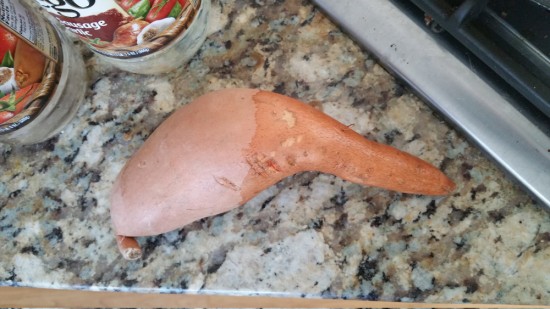How to start and grow new sweet potatoes
June 28th, 2016I’ve been working on this post for months, because it is a months long process. Taking pictures along every step of the way, documenting the process. And then I lost a ton of pictures. I used some recovery software and was able to get some of them, but not all, so there are far fewer pictures in this post than I originally intended.
To grow sweet potatoes you don’t use seeds, you use slips, which are tiny sweet potato plants. To make these slips you need to put a sweet potato, or pieces thereof, into water for weeks. Roots will come first, and later sprouts will come out. There are two main ways to do this.
1. Whole Potatoes
I recommend buying organic sweet potatoes, or from a farmer, or use ones left over from your last harvest, because some store bought potatoes may have been sprayed with something that inhibits sprouting. Weirdly shaped ones work well. I used old pasta sauce jars and found some potatoes that would stick down in the jar while creating a cork like seal at the top.

Every sweet potato has two ends, a stem end and a root end. You need to learn how to identify these ends because it is the root end that needs to be submerged. Sometimes a bit of root or bit of stem will still be attached to the potato, in which case, you have an easy job. Otherwise you need to look closely at the spud, the root end tends to be pointier, and the stem end chubbier.

You will need to make sure the root end stays submerged constantly for weeks until you see sprouts. My batch done with whole potatoes like this did not produce well.
2. Potato Chunks
The second method is to cut your potatoes up into chunks and put the cut sides down into water, I used a 9″ cake pan to hold these. Here it is less necessary to identify the stem and root ends, but this method required more frequent water monitoring.

Overall I had much better production this way. This way also had the benefit that once the sprouts came I could raise the water level, allowing roots to start forming at the base of the sprout, then a few weeks later, I was able to cut off the sprout, leaving some roots attached.
I also tried slices that wouldn’t fit into my cake pans suspended in a cup of water. Which also did okay.

Harvesting the Slips
Once the slips get a decent size, 4-6 inches, you cut them off and put them back into a water container so they can develop roots on their own. At this point, a humidity tent like a plastic bag would help since their main water source, the roots attached to the potato/chunk, has just been severed. However if you did as I did above with the chunks, raising the water level, each slip might already have roots.

Once the slips have a good quantity of roots you can transplant them out into your garden and they will make more sweet potatoes for you.
You can also harvest several rounds of slips from each potato chunk, after you harvest the first round the roots the potato grew are still working and it should quickly send up more slips. The process is still very slow though, overall for me it took close to 10 weeks from start to finish.
Late in the Fall, before frost, you can probably take cuttings from any sweet potato vines in your garden, and if you have a nice indoor setup you can probably store them indoors over the winter, and then plant them back out in Spring, saving you this step. I intend to try that this winter and I will let you know how it goes.

July 11th, 2016 at 4:50 am
Haha wow that is a lot more complicated with more work than what I thought. I was basing myself on the Martian movie where you cut a potato in half, then place it in the soil.
July 19th, 2016 at 11:15 pm
Thanks for these wonderful instructions! I grew some sweet potatoes with my kids, it was a fin learning experience.
August 1st, 2016 at 4:46 am
Hello and thanks for the very descriptive and informative post! My whole family lo-o-ves sweet potatoes, loaded with cheese and bacon, glazed or roasted.. That’s why I’ve been thinking about growing our own in the backyard. Can you guys tell me how much potatoes do I need to get in order to plant an area of 8 square metres?
August 25th, 2016 at 12:53 am
I love the documentation of each stage! Sweet potatoes are great to grow since they are a excellent source of vitamin A, C, Manganese, Copper, vitamin B6, and potassium. It just proves you don’t need much space to grow wonderful plants and veggies.
February 6th, 2017 at 6:41 pm
Thank you for this post and pictures!
I’m straight on to it! Hope to get a batch out before winter here in Australia .